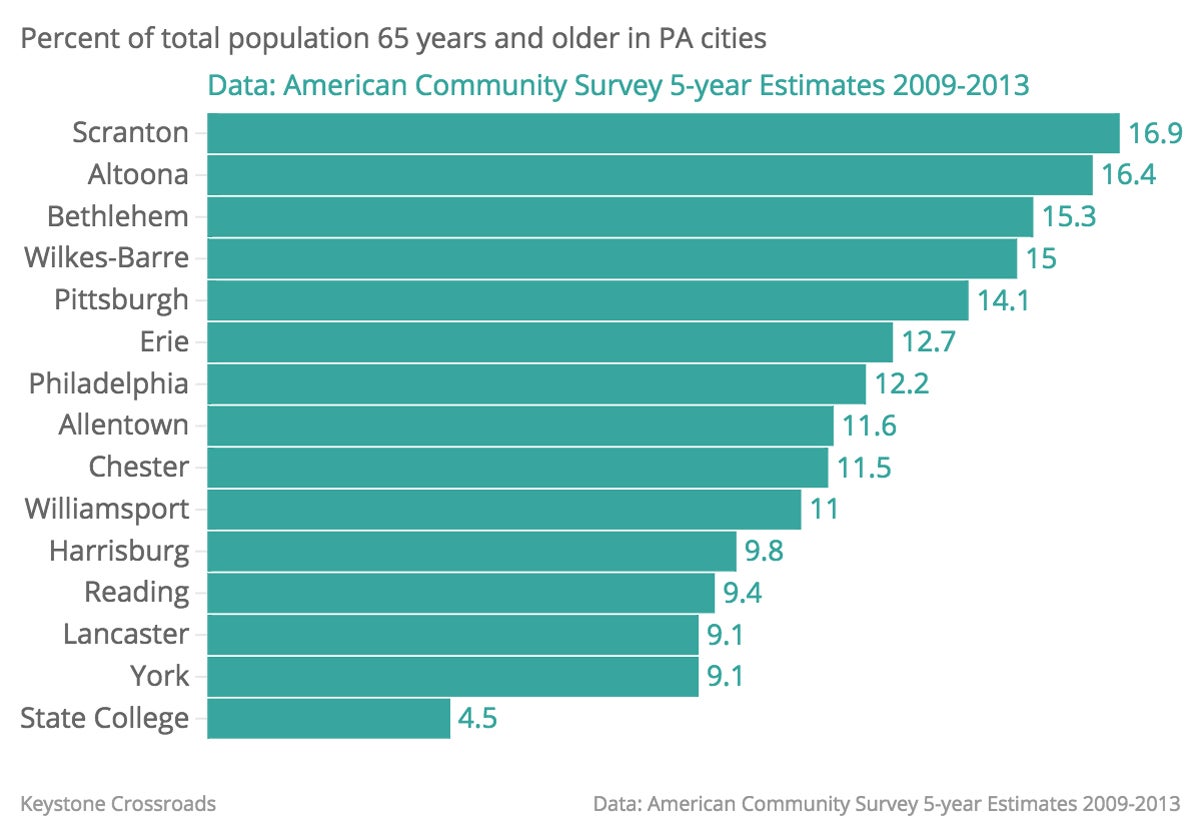How can Pennsylvania cities prepare for their aging populations?

A pedestrian passes into the light from beneath City Hall in Philadelphia, Pa.. (AP Photo/Matt Rourke)
A new report outlines the challenges cities face when it comes to aging populations and offers policy recommendations to local governments.
In the past few years, the impacts of “millennials” seemed to be a constant topic thrown around by policy wonks, public officials, and journalists alike. Less popular is the fact that many cities — especially in Pennsylvania — are experiencing the impacts of aging populations and the challenges that presents.
Populations around the world are getting older on average. A quarter of the world’s population will be 65 years or older by 2050 according to a new “Ageing in Cities” report by the Organisation for Economic Co-operation and Development (OECD).
In the United States, men are living almost a decade longer than they were 55 years ago. For women, life expectancy has increased by about eight years since 1960. The latest U.S. Census (2010) showed that there were more people 65 years and older than any other census.
Pennsylvania has the fourth highest percentage of residents 65 and older, just behind Florida, West Virginia and Maine, according to the U.S. Census. The chart below shows residents 65 and older as a percentage of total populations in Pennsylvania’s 15 largest cities.

Aging in cities presents new challenges
The new report by OECD outlines the potential challenges cities face when it comes to aging populations and offers policy recommendations local governments can consider to address those challenges.
“Unlike other potential challenges such as a financial crisis or natural disaster, aging trends and their impact can be fairly predictable. Cities can thus take action now to prepare themselves for the future demographic change,” writes Rolf Alter, OECD’s director of public governance and territorial development directorate in the report.
Some of the potential challenges outlined for cities include the need to redesign infrastructure, the lack of accessibility to affordable housing, shrinking labor forces, difficulty accessing services and jobs , social isolation and an increase in public health costs.
The OECD recommends a number of policy actions for cities to consider:
Develop a long-term vision and indicators to understand a city’s changing demographic structure
Increase older people’s opportunities for employment, volunteer work and healthy social activities
Provide affordable housing options and more accessible living environments
Redesign urban areas to improve accessibility and well being for older people and all ages
Philadelphia as a case study
The report includes a closer look at nine cities around the world, including Philadelphia.
In Philadelphia people 65 years and older accounted for about 12.2 percent of the city’s total population according to the American Community Survey 5-year Estimates from 2009-2013.
In the next five years, the report states, “The number of older adults aged 65-69 is expected to increase by 24 percent, the number of adults aged 70-74 is expected to increase by 19 percent and in African American, Latino, and Asian communities the number of adults over 85 is expected to double.”
For Philadelphia, the only U.S. city included in the case studies, the report shows that most older residents live away from Center City, in periphery neighborhoods. For this region, major challenges include, low income and poverty, health, housing and isolation concerns.
Between 2007-2013, the number of older people in Philadelphia earning $5,700 or less increased by 19 percent, states the report. And 38 percent of Philly’s older population above the age of 60 reported a problem being able to afford housing.
When it comes to the city’s housing policies that address the challenges of it’s aging population, the report notes the city’s zoning recommendations to incorporate the concerns of older residents into new building codes, and supporting low income seniors with local and federal housing assistance programs as progress.
Other policies or strategies for older residents noted in the report include the city’s close collaboration with the Philadelphia Corporation for Aging, AARP and other non-profit organizations, as well as initiatives to make Philadelphia a more walkable city.
WHYY is your source for fact-based, in-depth journalism and information. As a nonprofit organization, we rely on financial support from readers like you. Please give today.



